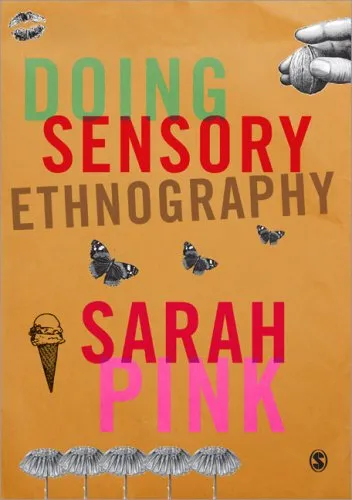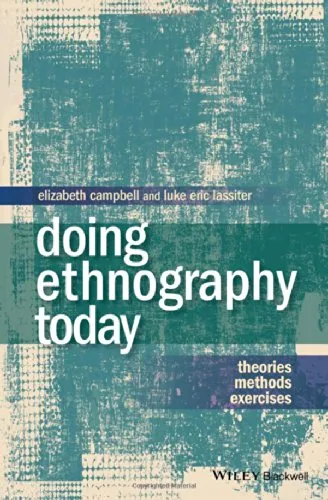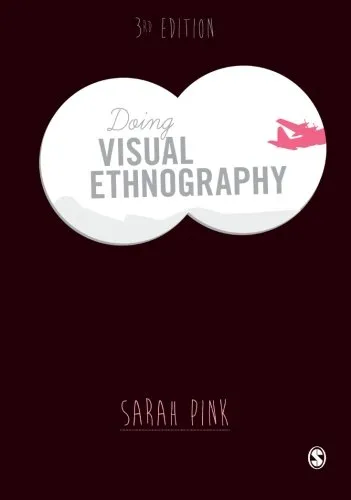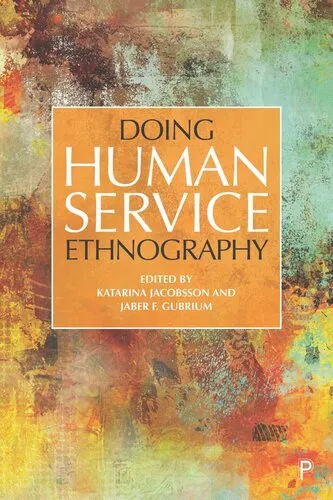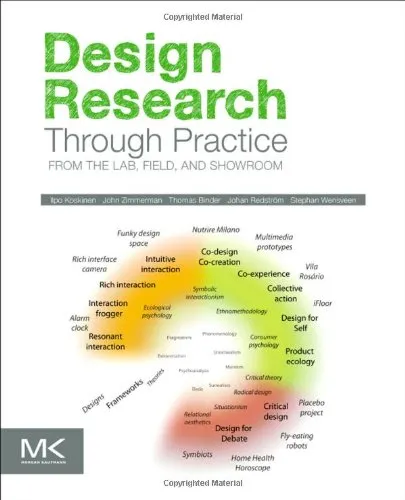Doing Design Ethnography
4.5
بر اساس نظر کاربران

شما میتونید سوالاتتون در باره کتاب رو از هوش مصنوعیش بعد از ورود بپرسید
هر دانلود یا پرسش از هوش مصنوعی 2 امتیاز لازم دارد، برای بدست آوردن امتیاز رایگان، به صفحه ی راهنمای امتیازات سر بزنید و یک سری کار ارزشمند انجام بدینکتاب های مرتبط:
معرفی کتاب "Doing Design Ethnography"
کتاب "Doing Design Ethnography" نوشته "Andrew Crabtree"، "Mark Rouncefield"، و "Peter Tolmie"، یکی از منابع برجسته در حوزه ethnography در طراحی است. این کتاب با رویکردی منحصر به فرد و عملی، مخاطبان خود را به دنیای پرچالش و پیچیده طراحی وارد میکند و نحوه استفاده از ethnography برای حل مشکلات طراحی را توضیح میدهد. این متن، راهنمایی برای طراحان، پژوهشگران و علاقهمندان حوزه UX و طراحی خدمات است تا ارزش مشاهده مستقیم و دادههای انسانی را در فرآیندهای طراحی درک کنند.
خلاصهای از کتاب
کتاب "Doing Design Ethnography" بر این باور استوار است که درک عمیق از رفتار، نیازها و تعاملات کاربران، کلید اصلی برای طراحی موفق است. نویسندگان کتاب از تجربههای چندین ساله خود در کار با پروژههای مختلف بهره گرفتهاند و با جزئیات به خواننده نشان میدهند که چگونه میتوان از روشهای ethnographic برای بهبود فرآیندهای طراحی استفاده کرد.
کتاب شامل مثالهای کاربردی و ابزارهای عملی است که به پژوهشگران کمک میکنند تا به صورت مستقیم با کاربران در محیط طبیعیشان تعامل کنند. همچنین، نویسندگان تأکید زیادی بر لزوم مشارکت تیم طراحی در این فرآیند دارند و نشان میدهند که چگونه یافتههای ethnographic میتوانند الهامبخش باشند و به راهحلهای طراحی منجر شوند که به طور واقعی نیازهای کاربران را برطرف میکنند.
نکات کلیدی و دستاوردها
- ارزش observation و روشهای qualitative research در طراحی موفق.
- روشهای جمعآوری و تحلیل دادههای ethnographic برای استفاده در طراحی.
- چگونگی شناسایی نیازها و الگوهای رفتاری کاربران از طریق fieldwork.
- نقش کلیدی همکاری تیم طراحی و محققان در فرآیند خلق راهحلها.
- بررسی نمونههایی واقعی از کاربرد تحلیل ethnographic در طراحی محصول و خدمات.
جملات معروف از کتاب
“Design Ethnography is not about observing from a distance, but immersing yourself in the world of the user to truly understand their needs and context.”
“Observation is not merely about seeing; it is about discovering the unseen realities that shape human behavior.”
“The key is not just understanding users, but translating that understanding into meaningful design.”
چرا این کتاب اهمیت دارد؟
کتاب "Doing Design Ethnography" نه تنها یک منبع عالی برای یادگیری روشهای ethnographic است، بلکه به طراحان روشهایی عملی و اثربخش ارائه میدهد تا طراحی خود را کاربرمحور کنند. در جهان امروز که رویکردهای مبتنی بر داده و تکنولوژی بر فرآیندهای طراحی غالب است، این کتاب به ما یادآوری میکند که انسان و نیازهای منحصربهفردش باید در قلب هر تصمیم طراحی قرار گیرند.
نویسندگان کتاب با زبانی ساده و روان، همراه با مثالهای کاربردی، نشان میدهند که چگونه میتوانند چالشهای طراحی را به فرصتهایی برای خلاقیت و نوآوری تبدیل کنند. برای هر کسی که به دنبال خلق محصولات و خدماتی است که واقعاً معنیدار و موثر باشند، مطالعه این کتاب ضروری است.
Introduction to "Doing Design Ethnography"
"Doing Design Ethnography" is a comprehensive guide that introduces readers to the practice and methodology of ethnography as applied to design. Authored by Andrew Crabtree, Mark Rouncefield, and Peter Tolmie, this book offers an in-depth exploration of how ethnographic methods can inform the design process, ensuring it aligns with people's real-world needs, behaviors, and social contexts. Written with academic rigor and practical insights, this book is an essential resource for designers, researchers, and social scientists eager to create user-centric solutions.
The book is not just about the theory of ethnography but precisely about its "doing." It walks readers through the entire process, from conducting fieldwork and gathering data to analyzing findings and incorporating them into design workflows. Whether you are a seasoned ethnographer or a novice in the field, "Doing Design Ethnography" guides you with clarity and actionable advice.
Detailed Summary of the Book
At its core, "Doing Design Ethnography" introduces ethnography as a practical and indispensable tool for design-related research. The book begins by outlining the principles of ethnographic inquiry, emphasizing the importance of immersing oneself into real-world contexts to understand users' lived experiences. This understanding is then used to inspire meaningful design innovations.
Crabtree, Rouncefield, and Tolmie highlight how ethnographic data contributes to uncovering the unspoken, often tacit aspects of human behavior that traditional design research may overlook. Key chapters focus on methodologies such as participant observation, contextual inquiry, and data analysis. The book also provides strategies for handling challenges like translating ethnographic insights into actionable design artifacts and navigating real-time design constraints.
Throughout the text, case studies are presented, illustrating the application of ethnographic techniques in real-world design projects. These examples help bridge the gap between theory and practice, demonstrating how ethnographic insights can lead to innovative and human-centered design outcomes.
Key Takeaways
- Ethnography is not a shortcut; it involves deep, immersive engagement with the social world.
- Understanding the context in which technology will be used is critical to designing solutions that resonate with users.
- Insights gained through ethnography often reveal opportunities for innovation and problem-solving that traditional approaches miss.
- Design ethnography bridges the gap between understanding user needs and the practicalities of design implementation.
- Ethnography equips designers and researchers with tools to navigate complexities and ambiguities in design processes.
Famous Quotes from the Book
"Design is, at its heart, an inherently social activity. Ethnography thus provides the tools to understand and design for the social world."
"The aim of doing design ethnography is not just to describe what people do but to uncover opportunities for making their lives better through design."
Why This Book Matters
In an age where technology and design continually reshape how we live, work, and interact, "Doing Design Ethnography" underscores the need for user-centric approaches that are grounded in human experience. By advocating for ethnographic methods, the authors challenge designers to go beyond superficial solutions and instead shape innovations that resonate deeply with users.
This book stands out because it merges academic rigor with real-world practicality. It has become essential reading for anyone engaging in human-computer interaction, user experience (UX) research, service design, or any field that involves designing for and with people. Whether you're a student, researcher, or a professional in the design industry, "Doing Design Ethnography" equips you with the methodological knowledge and practical skills to make a tangible difference in your projects and, ultimately, in people's lives.
دانلود رایگان مستقیم
شما میتونید سوالاتتون در باره کتاب رو از هوش مصنوعیش بعد از ورود بپرسید
دسترسی به کتابها از طریق پلتفرمهای قانونی و کتابخانههای عمومی نه تنها از حقوق نویسندگان و ناشران حمایت میکند، بلکه به پایداری فرهنگ کتابخوانی نیز کمک میرساند. پیش از دانلود، لحظهای به بررسی این گزینهها فکر کنید.
این کتاب رو در پلتفرم های دیگه ببینید
WorldCat به شما کمک میکنه تا کتاب ها رو در کتابخانه های سراسر دنیا پیدا کنید
امتیازها، نظرات تخصصی و صحبت ها درباره کتاب را در Goodreads ببینید
کتابهای کمیاب یا دست دوم را در AbeBooks پیدا کنید و بخرید
1261
بازدید4.5
امتیاز0
نظر98%
رضایتنظرات:
4.5
بر اساس 0 نظر کاربران
Questions & Answers
Ask questions about this book or help others by answering
No questions yet. Be the first to ask!






